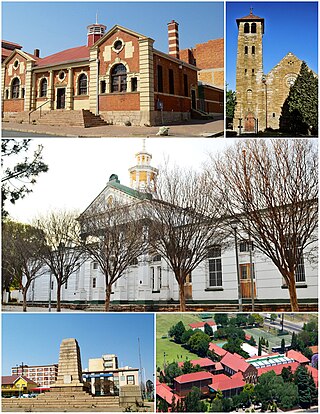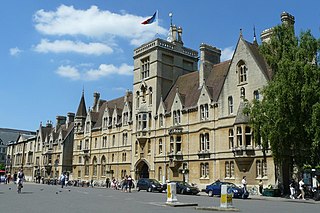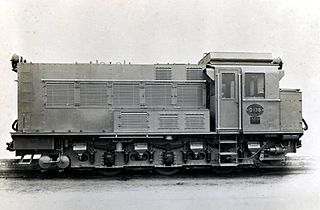Related Research Articles

The Transvaal Colony was the name used to refer to the Transvaal region during the period of direct British rule and military occupation between the end of the Second Boer War in 1902 when the South African Republic was dissolved, and the establishment of the Union of South Africa in 1910. The borders of the Transvaal Colony were larger than the defeated South African Republic. In 1910 the entire territory became the Transvaal Province of the Union of South Africa.

The Vaal River is the largest tributary of the Orange River in South Africa. The river has its source near Breyten in Mpumalanga province, east of Johannesburg and about 30 kilometres (19 mi) north of Ermelo and only about 240 kilometres (150 mi) from the Indian Ocean. It then flows westwards to its confluence with the Orange River southwest of Kimberley in the Northern Cape. It is 1,458 kilometres (906 mi) long, and forms the border between Mpumalanga, Gauteng and North West Province on its north bank, and the Free State on its south.

The Province of the Transvaal, commonly referred to as the Transvaal, was a province of South Africa from 1910 until 1994, when a new constitution subdivided it following the end of apartheid. The name "Transvaal" refers to the province's geographical location to the north of the Vaal River. Its capital was Pretoria, which was also the country's executive capital.

Johannesburg is a large city in Gauteng Province of South Africa. It was established as a small village controlled by a Health Committee in 1886 with the discovery of an outcrop of a gold reef on the farm Langlaagte. The population of the city grew rapidly, becoming a municipality in 1898. In 1928 it became a city making Johannesburg the largest city in South Africa. In 2002 it joined ten other municipalities to form the City of Johannesburg Metropolitan Municipality. Today, it is a centre for learning and entertainment for all of South Africa. It is also the capital city of Gauteng.

The Witwatersrand Gold Rush was a gold rush that began in 1886 and led to the establishment of Johannesburg, South Africa. It was a part of the Mineral Revolution.

Vereeniging is a city located in the south of Gauteng province, South Africa, situated where the Klip River empties into the northern loop of the Vaal River. It is also one of the constituent parts of the Vaal Triangle region and was formerly situated in the Transvaal province. The name Vereeniging is the Dutch word meaning "association".

The East Rand is a major urban area located in the Gauteng province of South Africa. It is the urban eastern part of Witwatersrand that is functionally merged with the Johannesburg conurbation. The region extends from Alberton in the west to Springs in the east, and south down to Nigel. It includes the towns of Bedfordview, Benoni, Boksburg, Brakpan, Edenvale, Germiston, Kempton Park, Linksfield and Modderfontein. The East Rand is known as the transport hub of Johannesburg and includes Africa's largest and second busiest airport, OR Tambo International Airport.

Springs is a former independent city that is now part of the City of Ekurhuleni, based in the east of Johannesburg, in Gauteng Province, South Africa. It lies 50 km (31 mi) east of Johannesburg and 72 km (45 mi) southeast from Pretoria. Its name derives from the large number of springs in the area, and its estimated population is more than 121,610 in 2011. It is situated at 1628 m (5,340 ft) above sea level.
The Netherlands–South African Railway Company or NZASM was a railway company established in 1887. The company was based in Amsterdam and Pretoria, and operated in the South African Republic (ZAR) during the late 19th century. At the request of ZAR president Paul Kruger, the NZASM constructed a railway line between Pretoria and Lourenço Marques in Portuguese East Africa.

Boksburg is a city on the East Rand (Ekurhuleni) of Gauteng province of South Africa. Gold was discovered in Boksburg in 1887. Boksburg was named after the State Secretary of the South African Republic, W. Eduard Bok. The Main Reef Road linked Boksburg to all the other major mining towns on the Witwatersrand and the Angelo Hotel (1887) was used as a staging post.
ArcelorMittal South Africa is part of the steel company Arcelor-Mittal. The company was originally Iscor Ltd., a South African parastatal steel company. It was founded in 1928 and was first listed on the JSE Securities Exchange in 1989.

Johannesburg Park Station is the central railway station in the city of Johannesburg, South Africa, and the largest railway station in Africa. It is located between the Central Business District and Braamfontein, in the block bordered by Rissik, Wolmarans, Wanderers, and Noord Streets. Park Station lies on the main Witwatersrand railway line that runs East-West from Krugersdorp to Germiston. The first four stations to the east are Doornfontein, Ellis Park, Jeppe and George Goch Stations.

Thomas Price Stratten was a South African engineer. He went to Oxford on a Rhodes Scholarship, followed by two years at American General Electric. He returned to South Africa in 1929 to the position of assistant electrical engineer at De Beers Consolidated Mines. He took senior positions at Iscor, the Union Corporation and Escom. After a time spent in the Directorate of War Supplies, he went on to successfully expand SAPPI's operations and was president of the South African Institute of Electrical Engineers during the 1940s.

The South African Railways Class DS1 of 1939 was a diesel-electric locomotive.

The Electricity sector in South Africa is an important part of energy in South Africa. Most power stations in South Africa are owned and operated by the state owned enterprise, Eskom. These plants account for 80% of all the electricity produced in South Africa and 45% of all electricity produced on the African continent.

The Witwatersrand Command was a Command of the South African Army. It was one of the ten regional commands, which, with the Walvis Bay Military Area, made up the Territorial Force.

Rand Water is a South African water utility that supplies potable water to the Gauteng province and other areas of the country and is the largest water utility in Africa. The water is drawn from numerous sources and is purified and supplied to industry, mining and local municipalities and is also involved in sanitation of waste water.
Anglovaal Group was one of six large South African holding conglomerates that had interests in mining, finance and industry. It was formed in 1933 as the Anglo-Transvaal Consolidated Investment Company Limited with interests initially in mining. In 1981, it became Anglovaal Limited. It was majority owned throughout its existence by the Hersov and Menell families. In the late 1990s, it would form into two separate companies, Anglovaal Industrial Holdings (AVI) and Anglovaal Minerals (Avmin). As a family owned business, all family interests were to be diluted by 2001. By 2003, Anglovaal Minerals became part of African Rainbow Minerals Limited, a listed black empowerment company.
Johannes Petrus Meyer was a politician, member of the Volksraad of the South African Republic, mining entrepreneur, and farmer; he is the man for whom Meyerton and Meyersdal are named.
Charles Butters was an American metallurgist, engineer and mine owner. A graduate of the University of California, he moved to Southern Africa in 1890 to construct a chlorination plant for Hermann Eckstein & Company. Whilst there Butters pioneered the use of the gold cyanidation process for extracting the metal from low grade ore, which opened up new deposits in Witwatersrand. He also developed other methods that increased extraction efficiency. Butters left Eckstein in 1894 to jointly found a new firm, the Rand Central Ore Reduction Company. He joined the Johannesburg Reform Committee in 1895, a group of mostly immigrants to South Africa who demanded, among other things, a stable constitution, an independent judiciary, and a better educational system; he participated in the Jameson Raid, a botched attempt against the South African Republic, and was fined $2,000.
References
- 1 2 3 4 5 6 7 8 9 10 11 12 13 14 15 16 17 18 19 20 21 22 23 24 25 26 27 28 29 30 31 32 33 34 35 36 37 38 39 40 41 Christie, Renfrew (1984). Electricity, industry, and class in South Africa. Internet Archive. Albany, N.Y.: State University of New York Press. ISBN 978-0-87395-854-7.
- 1 2 3 4 5 6 7 8 9 Klingenberg, Georg (1916). Large Electric Power Stations: Their Design and Construction, with Examples ... University of Wisconsin - Madison. D. Van Nostrand company.
- ↑ Electric capitalism : recolonising Africa on the power grid. Internet Archive. London ; Sterling, VA : Earthscan ; Cape Town : HSRC Press. 2009. ISBN 978-1-84407-714-4.
{{cite book}}: CS1 maint: others (link) - 1 2 3 4 5 6 7 8 9 "Electric Power Supply in the Transvaal". The Times of London. 29 June 1910. p. 15 – via Gale.
- 1 2 3 4 Transactions of the Seventh Commonwealth Mining and Metallurgical Congress. Internet Archive. Johannesburg: South African Institute of Mining and Metallurgy. 1961.
{{cite book}}: CS1 maint: others (link) - ↑ "Victoria Falls Power Expropriation". The Times of London. 7 February 1947. p. 9 – via GALE|CS152781895.
- 1 2 "Victoria Falls & Transvaal Power". The Times of London. 3 September 1948. p. 8 – via GALE|CS135218979.
- ↑ "Power Company's Sale". The Times of London. 19 May 1948. p. 9 – via GALE|CS152258227.
- ↑ "Johannesburg Consolidated Investment". The Times of London. 29 November 1948. p. 9 – via GALE|CS152520573.
- ↑ "City News in Brief". The Times of London. 17 March 1949. p. 7 – via GALE|CS119228529.
